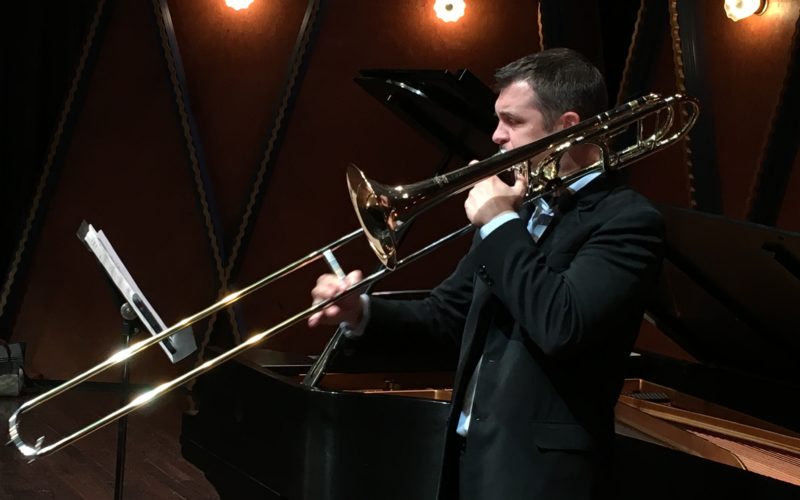BECCA MARTIN-BROWN
bmartin@nwadg.com
“The trombone has become known as a legitimate soloistic instrument really only in the last 70 years,” says Cory Mixdorf, an assistant professor specializing in trombone at the University of Arkansas. “This duration of time is dwarfed by other instruments such as the violin or piano, which have hundreds of years worth of solo repertoire. … When playing in an orchestra, you’re really a part of a team that’s led by the director.”
Either way, he says, it’s all about “how to form” the story the musician wishes to convey.
On Nov. 3, it will be Mixdorf’s job to help the Symphony of Northwest Arkansas tell the tales of Leonard Bernstein’s Three Dance Episodes from “On the Town”; Brahms’ Symphony No. 1; and Finnish composer Einojuhani Rautavaara’s Come un sogno from Symphony No. 7 — a program SoNA music director Paul Haas calls “exciting and evocative.”
Mixdorf talked about music, the trombone and his family in an email chat with What’s Up!
Q. What is your first memory of hearing the trombone? And what made you fall in love with it?
A. I vividly remember the day I got to try the different instruments to determine what I would play in fifth grade band. I tried REALLY hard specifically on the trumpet and drum because that’s really what I wanted to play. But the band director told me that I’d be most successful at the trombone. (To this day, I’m not sure if that was the truth, or if he just needed more trombonists in the band. Either way, it worked out well for me!)
Q. How does the trombone function in an orchestra?
A. You do your part to fit in and make sure you’re filling your musical role properly. For trombonists, that usually means providing textural support to the melody. But often we’re featured for one of our two strengths: strong, powerful projection of sound or delicate chorale settings. In fact, one of the most famous orchestral trombone chorales occur in the fourth movement of the Brahms symphony that will be played on this coming SoNA concert. I’m frequently taken aback at the feat of getting 60-plus musicians working together to make one magnificent musical product.
Q. What do you love about the Bernstein pieces that you’ll be playing?
A. There are a couple things about Bernstein that stand out to me. I love how he takes the unconventional and makes it sound natural. … This is very true harmonically as well. … I also enjoy Bernstein’s ability to infuse jazz into his classical works. This was true in “West Side Story” but is also a big part of what will be heard in the SoNA performance of music from “On the Town.”
Q. You’ve already got your own quintet of children! Are they musical?
A. As much as I love performing and teaching for a living, it still pales in comparison to my adoration for my family. My wife (Elizabeth) and I have five kids, Miles (10), Madelyn (8), Mason (7), Meyer (2), and Montgomery (10 months). Miles is involved in piano lessons, but can’t wait for the opportunity to play drum set. They all sing – even the 2-year-old. My wife studied voice at DePaul University, so they’ve all got some musical blood in them. When the weather is bad and they can’t play outside, it’s not uncommon for the karaoke machine to make an appearance in our living room with everyone taking a turn!
__
FAQ
Masterworks I:
SoNA Opener
WHEN — 7:30 p.m. Nov. 3
WHERE — Walton Arts Center in Fayetteville
COST — $32-$55
INFO — 443-5600
BONUS — Ticketholders are invited to attend a pre-concert Creative Conversation with Maestro Haas at 6:30 p.m. in Baum Walker Hall.



